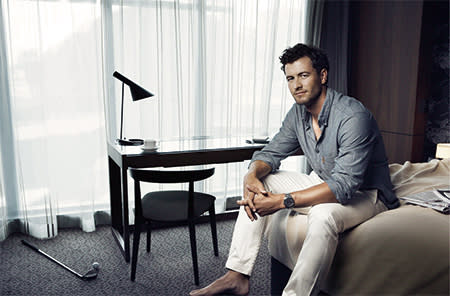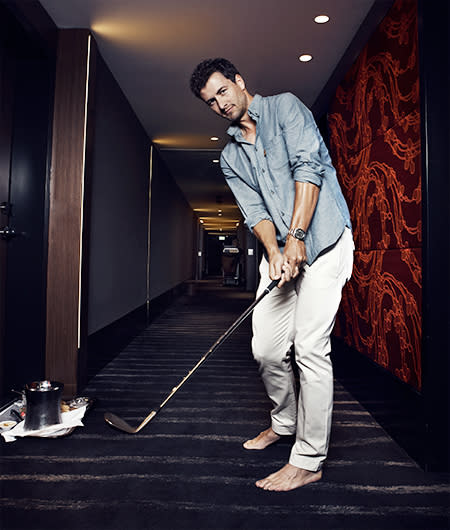Adam Scott's road to victory
By Daniel Williams
In a Sydney hotel room Adam Scott is killing time playing golf’s version of keepie-uppies, nonchalantly middling a ball on the sharply angled face of his pitching wedge. Ping, ping, ping . . . after some 20 strikes he snatches up the Titleist with his left hand and resumes chatting with his visitors. Looking suntanned and relaxed in T-shirt and shorts, one ear tuned to the TV where the Australian cricket team is floundering in a home Test match (“They’re in a world of hurt,” Scott deadpans), and with his tomorrow all planned (some time ago he called elder statesman Tom Watson to book him for a practice round at The Lakes), the handsome Scott with his oh-so-silky swing is making the game of life look a little too easy.
It’s illusory, of course. As it does to all of us, fate cranks back occasionally and lands mighty blows on the world No.7. Last July it had him believing that after more than a decade of hype and struggle he was about to break through to claim his first major championship – the Open at England’s Royal Lytham & St Annes.
Alas, having been cruising at four shots up with four holes to play, Scott finished with a quartet of bogeys, handing the spoils to his fast-finishing friend, veteran South African Ernie Els.
To Scott’s supporters, second place felt like a kick in the guts. The player’s own feelings were more complex, and we’ll come to those.
Did Scott fall prey to the same predator that may have invaded your central nervous system as you’ve closed in on something precious: the beast of anxiety that strangles your talent and rhythm just when you need them most?
This was the question Scott would sooner or later have to confront. But while still at the course he faced a more immediate challenge: getting through the next couple of hours without emotionally unravelling.
Golf’s a tyrant. While requiring consistently square contact with a devilishly small ball, it also expects its pros to be exemplars of temperance.
When Scott missed his putt on the 18th, protocol demanded he accept calamity without palpable distress, seek out Els, embrace him and whisper magnanimous platitudes in his ear, before smiling through the presentation and enduring the inquisitions.
He did it all with a graciousness that won him legions of new admirers. Perhaps it was enough to make you sheepish about the times you’ve turned the air blue over a duffed chip or wayward drive at your local, or been the sore loser after a contest that didn’t amount to a hill o’ beans.
“I was shattered. I couldn’t believe it was happening,” says Scott, 32, of those last four holes. When it was over, to keep himself together he fell back on “my upbringing, my respect for the game and the role models I’ve followed”.
Related: Get Adam Scott's tips for staying cool under pressure
And there was something else. Feistier in his youth, Scott some time ago grasped the value of self-control and the futility of self-pity. Likewise, he knows, the seeds for the sweetest-tasting fruit are planted in famine.
By storming home to win a tense Australian Masters last November, Scott announced to the world that the competitor to emerge from the Open wreckage is a more resilient model, who instead of being haunted by the ghosts of Royal Lytham is ready to go one better the next time knuckles are whitening during the final stages of a major – perhaps at the US Masters, beginning April 11.
Moreover, Scott’s experience could illuminate your shortcut to securing the triumphs that have been slipping through your fingers.
Be the hardhead
On reflection, the Open wound stung worst the next day, when Scott awoke feeling flatter than an ironing board and decided to retreat to his hideaway in the mountains of Crans Sur Sierre in Switzerland. Sensing his boy shouldn’t be alone, his dad went with him, and over the next few days father and son spent most of their time in front of the TV watching the Danish drama series The Killing, while avoiding seeing anything about the Open. When the time came to analyse what had happened in England, Scott wanted to do it without the lingering static of third-party speculation.
After a few days with his dad, the time had come. “You can’t bury your head in the sand,” advises Scott. “I went over the whole thing with my coach (Brad Malone) and my caddie (Steve Williams). We were all gutted, but we had to put everything out there and talk about it. I got their thoughts and I gave them mine.”
Related: Crush the ball off the tee with the golf workout to improve your long game
Scott says he reviews all big setbacks with what he hopes is a dispassionate, clear-eyed realism. How else can you learn from them? But in this case he could not bring himself to file the Open in the folder marked “Personal Disasters”.
The truth: he was thrilled for the most part with how he’d played. So much so, he explains, that if he were to tell you about all the things he’d done well over the four rounds, he would sound boastful. Pride was abundant and he allowed himself to feel it, just as you’re entitled to hang onto the good in something you’ve done that lacked a happy ending.
Scott’s findings? That flaws in communication between he and caddie Williams had helped things go belly up at the end. Williams used to carry Tiger Woods’ bag and the pair dealt with club selection in a way that worked superbly for the 14-time Major winner. “But we don’t all have the same mindset,” says Scott. “We don’t all have the same strengths. Steve and I had to harmonise the way we work under that kind of situation.”
Scott concluded nerves played little role in derailing him. In fact, he reckons he might have become too relaxed down the straight. “What I’ve learned is you can’t allow yourself to feel comfortable until the job is done,” he says. “Whatever levels of intensity and focus get you into a winning position, you have to maintain them all the way to the end.”
Make poise a habit
Scott still knows all about tension – how in a heartbeat (or a skipped one) it can make movements that are normally automatic feel as straightforward as platform diving.
Chances are your darkest sporting moments have occurred not when a superior opponent has cleaned your clock, but rather when you’ve folded against someone unfit to tie your shoelaces.
What you need to realise, says Scott, is that you can’t be a hothead or kneejerk pessimist in everyday life and expect to maintain clarity of thought and precision of execution when the telling moments arrive.
“I’d be surprised if you were a guy who burnt the toast and wrecked the toaster who could then keep it together under pressure,” he says.
“Look, I’m a calm, even person, but I have anger in me. It gets bottled up and a couple of times a year there’s an eruption.” But only when practising. For a small proportion of sportsmen, he says, venting strong emotion while competing can help by sharpening the competitive edge. But for him it doesn’t work: he can’t reset his dials in time to feel calm over his next shot. “If you’re a competitive person you’re never going to be completely flatline, but you need to know your tipping point.”
Ice in your veins
From sportsmen over the years, Scott has picked up various techniques for preventing meltdown, like Woods’ habit of slowing down his breathing and stride to control his heart rate.
There’s also the mindset – most often ascribed to tennis great Jimmy Connors – of viewing critical moments as carrying not pressure but opportunity.
“The guys who are successful under pressure . . . they love it,” says Scott. “You get in that situation and it’s not as bad as you thought it was going to be because you’re there and you want to be there.”
Boiled down, he adds, nerves are manifestations of a lack of confidence. And your only recourse is practice. “If you’ve done the work, really done the work, then you’re going to be confident and you’re going to get the results.”

 Yahoo Lifestyle
Yahoo Lifestyle 

